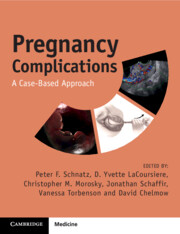Book contents
- Pregnancy Complications
- Pregnancy Complications
- Copyright page
- Contents
- Contributors
- Preface
- Note from the Editor-in-Chief
- Normal Laboratory Values (Conventional Units) []
- Section 1 Antepartum (Early Pregnancy)
- Section 2 Antepartum (Mid-trimester)
- Section 3 Antepartum (Late Pregnancy)
- Section 4 Antepartum (Medical Complications)
- Section 5 Antepartum (Infectious Complications)
- Section 6 Intrapartum/Delivery
- Case 46 A 40-Year-Old at 41 Weeks with a Closed Cervix after 12 Hours of Induction
- Case 47 A 25-Year-Old at 39 Weeks’ Gestation Presents with Regular Contractions and Minimal Cervical Change
- Case 48 A 35-Year-Old at 40 Weeks with Ruptured Membranes and Arrest of Cervical Dilation at 7 cm for 3 Hours
- Case 49 A 30-Year-Old at 36 Weeks’ Gestation with Breech Presentation
- Case 50 A 25-Year-Old at 39 Weeks’ Gestation with Brow Presentation at 9 cm Dilation
- Case 51 A 30-Year-Old at 39 Weeks’ Gestation with Fever in Labor
- Case 52 A 20-Year-Old at 39 Weeks’ Gestation with Persistent Occiput Posterior Presentation, Arrest of Descent, and Worsening Fetal Heart Rate Tracing
- Case 53 A 25-Year-Old at 40 Weeks’ Gestation with a Cesarean Delivery after a Failed Vacuum
- Case 54 A 25-Year-Old at 40 Weeks’ Gestation with Broad Ligament Extension during Cesarean Delivery
- Case 55 A 25-Year-Old at 40 Weeks’ Gestation with Urine Noted in Operative Field during Repeat Cesarean
- Case 56 A 20-Year-Old with a Fourth-Degree Perineal Laceration
- Case 57 A 25-Year-Old at 39 Weeks’ Gestation with Abdominal Pain, Vaginal Bleeding, and Worsening Fetal Heart Rate Tracing during TOLAC
- Case 58 A 40-Year-Old at 39 Weeks’ Gestation Becomes Unresponsive during the Second Stage of Labor
- Case 59 A 45-Year-Old at 39 Weeks’ Gestation Presents in Ventricular Fibrillation Undergoing CPR
- Case 60 A 35-Year-Old with a Vaginal Mass and Hemorrhage Immediately after Delivery
- Case 61 A 30-Year-Old with an Undelivered Placenta 30 Minutes Following Delivery
- Case 62 A 30-Year-Old at 38 Weeks’ Gestation with “Turtle Sign” Noted at Delivery
- Section 7 Postpartum
- Section 8 Fetal Complications
- Section 9 Placental Complications
- Section 10 Complications of the Cord, Amnion, and Gravid Uterus
- Section 11 Psychosocial Considerations
- Index
- References
Case 56 - A 20-Year-Old with a Fourth-Degree Perineal Laceration
from Section 6 - Intrapartum/Delivery
Published online by Cambridge University Press: 08 April 2025
- Pregnancy Complications
- Pregnancy Complications
- Copyright page
- Contents
- Contributors
- Preface
- Note from the Editor-in-Chief
- Normal Laboratory Values (Conventional Units) []
- Section 1 Antepartum (Early Pregnancy)
- Section 2 Antepartum (Mid-trimester)
- Section 3 Antepartum (Late Pregnancy)
- Section 4 Antepartum (Medical Complications)
- Section 5 Antepartum (Infectious Complications)
- Section 6 Intrapartum/Delivery
- Case 46 A 40-Year-Old at 41 Weeks with a Closed Cervix after 12 Hours of Induction
- Case 47 A 25-Year-Old at 39 Weeks’ Gestation Presents with Regular Contractions and Minimal Cervical Change
- Case 48 A 35-Year-Old at 40 Weeks with Ruptured Membranes and Arrest of Cervical Dilation at 7 cm for 3 Hours
- Case 49 A 30-Year-Old at 36 Weeks’ Gestation with Breech Presentation
- Case 50 A 25-Year-Old at 39 Weeks’ Gestation with Brow Presentation at 9 cm Dilation
- Case 51 A 30-Year-Old at 39 Weeks’ Gestation with Fever in Labor
- Case 52 A 20-Year-Old at 39 Weeks’ Gestation with Persistent Occiput Posterior Presentation, Arrest of Descent, and Worsening Fetal Heart Rate Tracing
- Case 53 A 25-Year-Old at 40 Weeks’ Gestation with a Cesarean Delivery after a Failed Vacuum
- Case 54 A 25-Year-Old at 40 Weeks’ Gestation with Broad Ligament Extension during Cesarean Delivery
- Case 55 A 25-Year-Old at 40 Weeks’ Gestation with Urine Noted in Operative Field during Repeat Cesarean
- Case 56 A 20-Year-Old with a Fourth-Degree Perineal Laceration
- Case 57 A 25-Year-Old at 39 Weeks’ Gestation with Abdominal Pain, Vaginal Bleeding, and Worsening Fetal Heart Rate Tracing during TOLAC
- Case 58 A 40-Year-Old at 39 Weeks’ Gestation Becomes Unresponsive during the Second Stage of Labor
- Case 59 A 45-Year-Old at 39 Weeks’ Gestation Presents in Ventricular Fibrillation Undergoing CPR
- Case 60 A 35-Year-Old with a Vaginal Mass and Hemorrhage Immediately after Delivery
- Case 61 A 30-Year-Old with an Undelivered Placenta 30 Minutes Following Delivery
- Case 62 A 30-Year-Old at 38 Weeks’ Gestation with “Turtle Sign” Noted at Delivery
- Section 7 Postpartum
- Section 8 Fetal Complications
- Section 9 Placental Complications
- Section 10 Complications of the Cord, Amnion, and Gravid Uterus
- Section 11 Psychosocial Considerations
- Index
- References
Summary
Obstetric anal sphincter injuries (OASIS) are severe lacerations that extend into or through the anal sphincter complex. A thorough exam in the immediate postpartum period and familiarity with the anatomy is essential for the proper diagnosis and management. There is no difference in long-term complications regarding the use of an end-to-end anastomosis or overlapping technique to repair the external anal sphincter. It is reasonable to administer a single dose of a second-generation cephalosporin as antibiotic prophylaxis with third- and fourth-degree perineal lacerations. Proper postoperative care, including the avoidance of constipation, pelvic rest, good hygiene, pain control, and short-term follow-up visits, are key to avoiding complications.
Keywords
- Type
- Chapter
- Information
- Pregnancy ComplicationsA Case-Based Approach, pp. 171 - 173Publisher: Cambridge University PressPrint publication year: 2025

